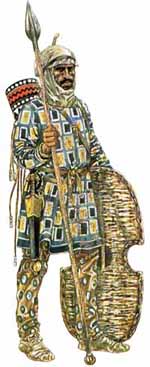
This picture shows one of the famous 'Immortals'. They formed the elite of the Persian army, and were called like this because men were assigned to replace the positions of fallen soldiers. This way the strength of the corps was always 10000 men. Only those who had Persian or Medic ancestors were allowed to become an Immortal as they had another important function: in times of peace formed they the bodyguard of the high king.
The equipment of the Persian Immortal.
His clothes in this picture were used in combat, he wore completely different clothes when he acted as the bodyguard of the king. That type of clothing is more ceremonial and is normally seen on sculptures in Persepolis. The ceremonial clothing was of course more subtle, but less practical on the battlefield. One of the main weapons of an Immortal were the short bow which was of little use against the heavy armoured Greek hoplites. His other main weapon was quite a short spear with an iron point and a silver counterbalance (the officers had a golden counterbalance). A short sword, or a big dagger, completed the weaponry of an Immortal.
A corset with metal plates is worn under his tunic to offer some protection. Compared to the elite of the Greek forces was he hardly armoured. In his left hand he is holding the gerron: a traditional shield made of wicker and leather. This shield gave him enough protection against arrows, but it certainly could not stop a well aimed thrust of a spear of a Greek hoplite while the Greek hoplon could stop such an attack. On his head he is wearing the tiara: a soft cap made of fabric which he could pull down over his face when he marched through a desert. His loose tunic is richly decorated with embroidery and was often painted in purple, blue, yellow, or white.
In spite of his courage was even the Immortal inferior to a Greek hoplite on the battlefield. The obsolete shield, the lack of greaves and helmet, and the fact that his only advantage, the bow, was useless against the Greek armoured hoplites made the Immortals of less strong than the hoplite. He was a professional soldier just like the Spartans, but the Persian army did not use a tactic which could stop the phalanx. Nevertheless were the Immortals extremely important on the battlefield, and during the battle of Plataea they only retreated after their leader Mardonius was killed. A reason for his inferior equipment might have been his value within the Persian armies which mostly depended on huge amounts of cavalry and archers. Later on the Persian infantry started to use the Greek hoplon and short sword, but they still hardly used any armour most of the time.
Of course were there more types of infantry in the Persian army. Many vanquished people from many different places were forced to fight in the Persian warmachine, and that explains the diversity of the Persian army. Besides their inferior equipment was this also a big disadvantage while fighting the Greeks. The Persians did not form an unity, they did not fight in groups like a phalanx. On top of that fought they in a strange land. The Greeks knew the advantages and the disadvantages of the terrain, and they fought for their homeland... they had a much higher moral.